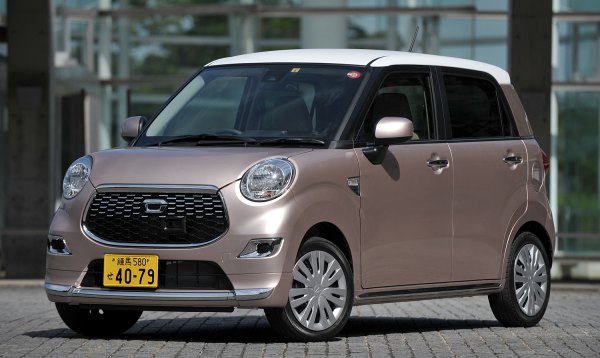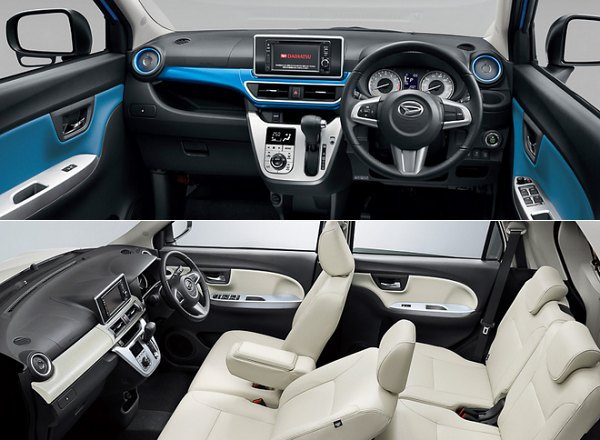Published
on 7
Jan 2017
|
All rights reserved.
|
|
|

Cast Style
|
|
|
|
A prominent front
grille, big round headlamps, blackened pillars, white or black roof,
lots of chrome and high degree of customization… you think I am
describing Mini? No, it is Daihatsu’s K-car, Cast. Copycat is
disgusting, but having seen countless of A-grade clones from China,
maybe we should not blame the Japanese too much. I suppose BMW will not
blame it either, because the Daihatsu is much taller, boxier and
therefore less visually desirable than the Mini. It proves that K-cars
are difficult
to look handsome. While Suzuki masters the required design technique to
break the mold,
Daihatsu is not yet good enough.
Just like Mini, the Cast is supposed to be a premium product. While its
underpinnings are shared with Move and other Daihatsu K-cars,
it is packaged and equipped to take the upper end of the class.
Usually, cars showing distinctive taste could charge higher prices.
However, going too niche could narrow its customer base and limit its
sales volume. As the K-car segment is increasingly competitive
(especially since the Japanese government cut its tax benefits),
manufacturers
have
to make sure their niche cars can sell in high volume, otherwise they
could hardly turn a profit. How to do that? Daihatsu opted to develop
the Cast into 3 distinctive variants, i.e. Style, Sport and Activa.
They are practically the same except some of the skins that make them
look different and appeal to different kinds of customer. The same
concept has been demonstrated by Copen
already.

Left: Cast Activa; Right:
Cast Sport
|
|
|
|
Style is the prettiest of the trio. It looks more premium thanks to the
plated chin spoiler and side skirts. It should appeal to female
drivers. In contrast, Sport is oriented to men. It gets a more
aggressive chin spoiler and larger, 16-inch wheels. Moreover, it is
served with only turbo engine. Activa is a semi-SUV. Its suspension is
jacked up by 30mm to deal with rough roads, while plastic body
claddings are added to resist scratch. Although 4WD system is optional
like its siblings, it gets an extra hill descend control. As for
customization, all three cars allow quite a lot of different color
combinations in body, roof, door mirrors and C-pillar panels, which are
made of resin, hence easily replaceable (another technique learned
from Copen). BTW, in order to simplify the production process, the roof
color is not painted but by wrapping a thin layer of PVC.
Inside, the dashboard architecture is common to all three variants, but
the Style has a lid covering the storage area in front of the
passenger. The cabin employs a 2-tone color scheme which is matched
with the body color. It looks smart, although the plastics are
expectedly hard and shiny. Space is adequate for average Japanese
adults, but the rear seat is hard and flat thus offers little comfort.
Moreover, taller passengers will find their knees raised as the rear
seat is mounted low in relation to the floor level. The rear seat is
50/50-split and can slide back and forth for a range of 240mm, but the
latter feature is not very useful on such a small car.
 |
|
|
|
For driving, the Cast is nothing special. Its tiny 3-cylinder engines,
no matter naturally aspirated or turbocharged, are less powerful than
the equivalents offered by Suzuki, and power delivery is peaky.
Moreover, the Cast is not especially light, so you do need some more
patience to overtake or to get uphill. Rev the engines hard and you
will get a lot of engine noise. In corner, there is pronounced roll as
in the case of most tall-body K-cars. What’s unexpected is that the
Style rides quite hard, while the Activa with its softer, longer travel
suspension and higher profile tires offers a more comfortable ride. You
won’t buy these cars for driving excitement, so a more civilized manner
fits its purpose better.
However, given the premium price, we should expect more from the Cast
trio – more style, more performance, more refinement and more seating
comfort. You will be better served by B-segment cars like Suzuki Swift.
|
Verdict:   |
|